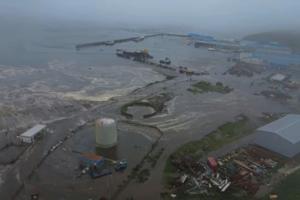A powerful earthquake, among the strongest ever recorded, recently struck off Russia’s remote Far East coast, triggering a tsunami that swept into a fishing port. Yet, remarkably, the “land of fire and ice” – the Kamchatka Peninsula – largely withstood nature’s fury, demonstrating impressive resilience and preparedness in the face of immense geological forces.
The initial tremors sent ripples of alarm across the region, with power outages reported in several areas and panicked residents briefly fleeing buildings. While a fishing port experienced significant inundation from the tsunami waves and a kindergarten sustained damage, the immediate aftermath revealed only a few minor injuries, a testament to effective pre-emptive measures and robust infrastructure.
Regional authorities were praised for their foresight, having anticipated such seismic activity and the subsequent waves. Their swift implementation of emergency protocols and proactive measures ensured the safety of residents, rapidly moving to introduce a state of emergency in affected zones, which ultimately prevented widespread destruction or major casualties.
Kamchatka, aptly nicknamed the “land of fire and ice,” is an intensely active volcanic region, boasting approximately 300 volcanoes, with 29 still active. Its perilous yet captivating landscape sits precariously close to an oceanic trench where two major tectonic plates converge, making it a hotspot for frequent earthquakes and tsunamis.
Stretching 1,200 kilometers, this vast peninsula, located nine time zones east of Moscow, borders the Pacific Ocean to its east and the Sea of Okhotsk to its west. With a sparse population of about 290,000, concentrated largely in its regional capital, Petropavlovsk-Kamchatsky, access is predominantly by helicopter due to limited road networks. Fishing forms the backbone of its economy, alongside a significant base for Russian nuclear submarines.
The magnitude of this recent quake puts it in an elite category, drawing comparisons to the devastating 9.1 magnitude earthquake that struck northeastern Japan in 2011. Incidents such as an operating room shaking during surgery highlighted the raw power of the event, yet inspections of hundreds of apartment buildings confirmed no evacuations were necessary, signaling structural integrity.
Despite warnings of potential tsunami waves reaching heights of 10 to 15 meters along parts of the Kamchatka coast, official reports indicated that the largest waves impacting populated areas and the nearby Kuril Islands were under 6 meters. Petropavlovsk-Kamchatsky, specifically, found protection from the worst of the tsunami due to its advantageous location within the Avacha Bay, though emergency workers did evacuate about 60 tourists from vulnerable black volcanic sand beaches.
In Severo-Kurilsk, Mayor Alexander Ovsyannikov confirmed that the fishing port bore the brunt of the tsunami, leading to the flooding of a fish factory and sweeping fishing boats out to sea. This immediate inundation also resulted in temporary power outages as authorities began assessing the full extent of the localized damage.
Kremlin spokesman Dmitry Peskov acknowledged the efficiency of the response, noting that timely quake warnings were issued, residents were evacuated promptly, and buildings largely withstood the intense shocks, underscoring the success of the region’s disaster preparedness and mitigation strategies.






Leave a Reply